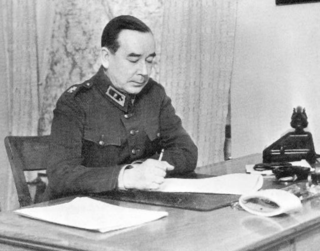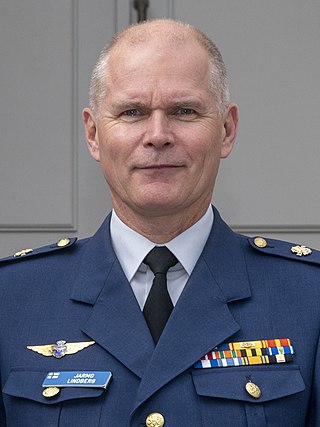
The Continuation War, also known as the Second Soviet-Finnish War, was a conflict fought by Finland and Nazi Germany against the Soviet Union during World War II. It began with a Finnish declaration of war on 25 June 1941 and ended on 19 September 1944 with the Moscow Armistice. The Soviet Union and Finland had previously fought the Winter War from 1939 to 1940, which ended with the Soviet failure to conquer Finland and the Moscow Peace Treaty. Numerous reasons have been proposed for the Finnish decision to invade, with regaining territory lost during the Winter War regarded as the most common. Other justifications for the conflict include Finnish President Risto Ryti's vision of a Greater Finland and Commander-in-Chief Carl Gustaf Emil Mannerheim's desire to annex East Karelia.

The Finnish Defence Forces (FDF) (Finnish: Puolustusvoimat, Swedish: Försvarsmakten) are the military of Finland. The Finnish Defence Forces consist of the Finnish Army, the Finnish Navy, and the Finnish Air Force. In wartime, the Finnish Border Guard becomes part of the Finnish Defence Forces.

Carl Gustaf Emil Mannerheim was a Finnish military commander, aristocrat, and statesman. He served as the military leader of the Whites in the Finnish Civil War (1918), as Regent of Finland (1918–1919), as commander-in-chief of the Finnish Defence Forces during the period of World War II (1939–1945), and as the sixth president of Finland (1944–1946). He became Finland's only field marshal in 1933 and was appointed honorary Marshal of Finland in 1942.

Karl Lennart Oesch was one of Finland's leading generals during World War II. He held a string of high staff assignments and front commands, and at the end of the Continuation War commanded three Finnish army corps on the Karelian Isthmus. He received numerous awards, including the Finnish Mannerheim Cross during his service. Following the end of the Continuation War, he was tried and convicted for war crimes relating to the treatment of Soviet prisoners-of-war.
TICOM was a secret Allied project formed in World War II to find and seize German intelligence assets, particularly in the field of cryptology and signals intelligence.
Between 1809 and 1917 Finland was an autonomous part of the Russian Empire as the Grand Duchy of Finland. Between 1881 and 1901 the grand duchy had its own army. Before that several other military units had also been formed.

The National Defence Radio Establishment is a Swedish government agency organised under the Ministry of Defence. The two main tasks of FRA are signals intelligence (SIGINT), and support to government authorities and state-owned companies regarding computer security.

The Armoured Brigade is a Finnish Army training unit located in Parolannummi, Hattula, in southern Finland. The brigade specialises in training armoured and anti-aircraft troops. In case of mobilization, the Finnish Defence Forces would field one armoured brigade. The war-time armoured brigade has a strength of around 5,700 men, and fields 63 main battle tanks, 110 infantry fighting vehicles, circa 100 armoured personnel carriers, mainly of Soviet origin, and roughly 70 other armoured vehicles. However, the remaining war-time armoured brigade is being phased out and replaced by smaller mechanized battle groups. The new mechanized battle groups will field the Leopard 2 MBTs that are not included in the organization of the contemporary war-time armoured brigades.
Operation Stella Polaris was the cover name for an operation in which Finnish signals intelligence records, equipment and personnel were transported to Sweden in late September 1944 after the end of combat on the Finnish-Soviet front in World War II. The purpose was to enable the signals intelligence activities against the advancing Russians to continue in Sweden and to prevent the equipment falling into the hands of the Soviet Union. A Soviet invasion was considered likely and plans were made to support guerrilla warfare in Finland after a possible occupation. The operation had its base in the small fishing village of Nämpnäs in Närpes, Ostrobothnia region, from where the archives were shipped to Swedish ports. The leaders of the operation were Colonel Aladár Paasonen, chief of Finnish military intelligence, and Colonel Reino Hallamaa, head of the Finnish signals intelligence section.
Signals intelligence by alliances, nations and industries comprises signals intelligence (SIGINT) gathering activities by national and non-national entities; these entities are commonly responsible for communications security (COMSEC) as well.

The Military Museum of Finland is the central museum of the Finnish Defence Forces and the national special museum of military history. It is located in Helsinki and it is part of the Finnish National Defence University. In 2018, the Military Museum's exhibitions in Suomenlinna had around 131,000 visitors. The most popular exhibition is the submarine Vesikko, visited by around 50,000 people annually. Military Museum's exhibitions in Suomenlinna are located at Manege and Artillery Maneage.

Reino Henrik Hallamaa was a Finnish Colonel and developer and head of the Finnish Radio Intelligence during World War II.

Johan Woldemar Hägglund was a Finnish lieutenant general during the Second World War, and an early volunteer of the Jäger Movement. He participated in the Eastern Front of World War I, the Finnish Civil War, the Winter War and the Continuation War, commanding army corps in the latter two. In 1944 and 1945, he was in charge of a committee investigating Finnish war crimes, especially those committed against prisoners of war.

The Intelligence Division of Defence Command is the unit in charge of Finnish military intelligence. Operational since the creation of the Finnish Defence Forces, its responsibility as a military intelligence service is to support the defence of Finland through information gathering and analysis with the Finnish Defence Intelligence Agency under its command.

Ari Tapani Puheloinen is a Finnish General who was Chief of Defence of the Finnish Defence Forces between 2009 and 2014.

Defence Command, organized as Headquarters during wartime, is the joint command headquarters of the Finnish Defence Forces and a central government agency. Active since 1918, it leads and monitors the execution of the duties prescribed to the Defence Forces, such as the military defence of Finland.

Jarmo Ilmari Lindberg is a retired Finnish general and former Chief of Defence from 2014 to 2019. Lindberg began his career as a fighter pilot, and was eventually promoted to Commander of the Finnish Air Force and then Deputy Chief of Staff, Logistics and Armaments in the Defence Command. He is also a member of the Parliament from the National Coalition Party since 2023.

The Unknown Soldier is a 2017 Finnish independent war drama film, an adaptation of the bestselling 1954 Finnish classic novel of the same name by Väinö Linna, literature considered part of the national legacy. Directed by Aku Louhimies, it is the first one based on the novel's manuscript version, Sotaromaani. Previously adapted in 1955 and 1985, the World War II film is presented from the point of view of a machine gun company of the Finnish Army during the Continuation War between Finland and the Soviet Union from 1941 to 1944. It was the most expensive Finnish motion picture at its release with a budget of €7 million.
Lauri Asko Antero Sarkola is a Finnish actor and theater manager. He studied at the Svenska Teaterskolan from 1963 to 1966. He had a long career at the Swedish-speaking Lilla Teatern, where he first starred in 1967–1974 and served as deputy director from 1972 to 1974. In 1974–1981 and 1984–1997, Sarkola was the director of Lilla Teatern. From 1982 to 1985, Sarkola worked as a professor at the Helsinki Theatre Academy. He directed the Helsinki City Theatre from 1998 to 2016.

War College was a Finnish war college active from 1924 to 1992. Founded first as a temporary institute, it was made permanent in 1930. At the end of 1992, it was merged with the Cadet School and the Battle School into the National Defence University.

















